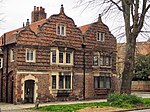RAF Clifton
Royal Air Force stations in YorkshireRoyal Air Force stations of World War II in the United KingdomUse British English from November 2017
Royal Air Force Clifton, or more simply RAF Clifton, is a former Royal Air Force station located 1.5 miles (2.4 km) north west of York city centre and 2.6 miles (4.2 km) south west of Haxby, North Yorkshire, England. The airfield was opened in 1936 as a civilian airport but by 1939 the station was taken by the Royal Air Force (RAF) for use in the Second World War and was returned in 1946 when the airport reopened. However, in 1955 the airfield was closed for good. The airfield during wartime was also known as RAF York and RAF Rawcliffe.
Excerpt from the Wikipedia article RAF Clifton (License: CC BY-SA 3.0, Authors).RAF Clifton
Grasmere Grove, York Rawcliffe
Geographical coordinates (GPS) Address Nearby Places Show on map
Geographical coordinates (GPS)
| Latitude | Longitude |
|---|---|
| N 53.980555555556 ° | E -1.1077777777778 ° |
Address
Grasmere Grove
Grasmere Grove
YO30 5SR York, Rawcliffe
England, United Kingdom
Open on Google Maps








